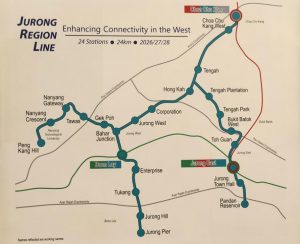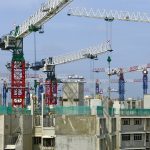With the Jurong Region Line project, commuters can look forward to seeing the trains in operation in 2026
Speaking at the signing of the Jurong Region Line contract for the supply of trains between Hyundai Rotem Company and Land Transport Authority (LTA), Minister for Transport said that the first Jurong Rail Line train should arrive in 2024. The Minister, Mr Khaw Boon Wan, said the signing ceremony marked two significant developments.
“First, we take another major step forward in the implementation of our 7th MRT Line, the Jurong Region Line. The JRL will support our plans to remake Jurong as a major business district. It will serve major activity nodes such as the Jurong Lake District, the Jurong Innovation District and Nanyang Technological University.
Residents will benefit from improved connectivity in the northwest. More direct journeys from North to West will become possible. For instance, a PSA worker from Choa Chu Kang West can half his journey time to Tuas Link station to around 30 minutes. An NTU student from Boon Lay MRT station will similarly half his journey time to around 15 minutes.
Second, we welcome a new international player – Hyundai Rotem Company or HRC – to the list of train suppliers for our MRT network.”

HRC will be supplying 62 trains for the Jurong Region Line project.
Table of Contents
HRC is not new to Singapore. LTA has worked with them before when they carried out mid-life refurbishment of Singapore’s first-generation trains for the North-South and East-West Lines. HRC has also supplied trains to metros in Seoul, Hong Kong and Vancouver. Mr Khaw said that his Ministry looked forward to a productive relationship with HRC.
The Minister said that HRC has committed to establish a base in Singapore, to facilitate knowledge transfer and technical support to the Jurong Region Line operator. This will also allow HRC to provide the operator with Long-Term Service Support for enhanced maintenance of these trains.
“Let me share with you some features of the new JRL trains. First, the trains will come with condition monitoring and diagnostic systems. This will allow the operator to track the performance of various systems on the trains and detect faults in real time. With this, the operator can do predictive maintenance and intervene before faults arise.
Second, the JRL trains will have emergency batteries, which will kick in should there be a prolonged loss of power supply. This allows train staff to pilot the trains to the next nearest station. This will shorten service recovery time. Third, the JRL trains will have wider train doors to facilitate movement of commuters in and out of the trains.”
Noting that the first JRL train should arrive in 2024 for testing and that commuters can look forward to seeing the trains in operation when JRL opens in 2026, Mr Khaw said that it is therefore a happy day for commuters.
The upcoming seventh MRT line, Jurong Region Line, is expected to lift the fortunes of not just the properties in Jurong Lake District, but also the real estate in Boon Lay and Choa Chu Kang. The new line will serve the Jurong area and the western part of Singapore. Jurong Region Line will connect residents in Choa Chu Kang, Boon Lay and the Tengah New Town, and will also connect the Nanyang Technological University (NTU), the Jurong Industrial Estate and the new Jurong Innovation District.
It will relieve pressure on the crowded Jurong East Interchange Station by directly connecting the north to the Jurong region via a new Jurong Region Line interchange station at Choa Chu Kang. The Jurong Region Line will be developed to support the Government’s urban decentralisation strategy, and car-lite policy.
The Minister previously said that the Jurong Region Line project marks a quantum leap in the Government’s improvement of transport infrastructure for Jurong.
The Jurong Region Line project will be 24km long with 24 stations, and will run above-ground. It will open in three phases, starting from 2026. The Jurong Region Line will give commuters route choices. For example, the two interchange stations at Choa Chu Kang and Boon Lay will connect the North-South Line (NSL) and East-West Line (EWL), giving commuters alternative travel routes. This will help to redistribute and relieve train loading between Choa Chu Kang and Jurong East stations, so that commuters can enjoy more comfortable rides
The Jurong Region Line is expected to help develop the Jurong Lake District (JLD) into the largest commercial hub outside the CBD. Beyond the Jurong Lake District, the Jurong Region Line will also support the development of the Jurong Innovation District into a next generation industrial estate.
The Jurong Region Line project is expected to boost the prices of properties not just in the Jurong Lake District area, but also in areas where the interchanges are expected to be built – in Boon Lay and Choa Chu Kang. Besides ramping-up the prices of landed and non-landed private properties in the western region of Singapore, the announcement of the Jurong Region Line may also lift the resale prices of Housing & Development Board (HDB) flats in that area.
Choa Chu Kang which is earmarked to be one of the interchanges for the new western line will especially benefit from this project.
Mr Paul Ho, chief mortgage officer at iCompareLoan said, “with the JRL, the Jurong Lake District project looks even more promising.”
Developments for the Jurong Lake District are centered around the Jurong East MRT station. With established businesses around the MRT station – like the International business park, IMM (a major shopping mall), along with other new shopping malls, a hospital, educational hubs, high rise offices and residential units.






